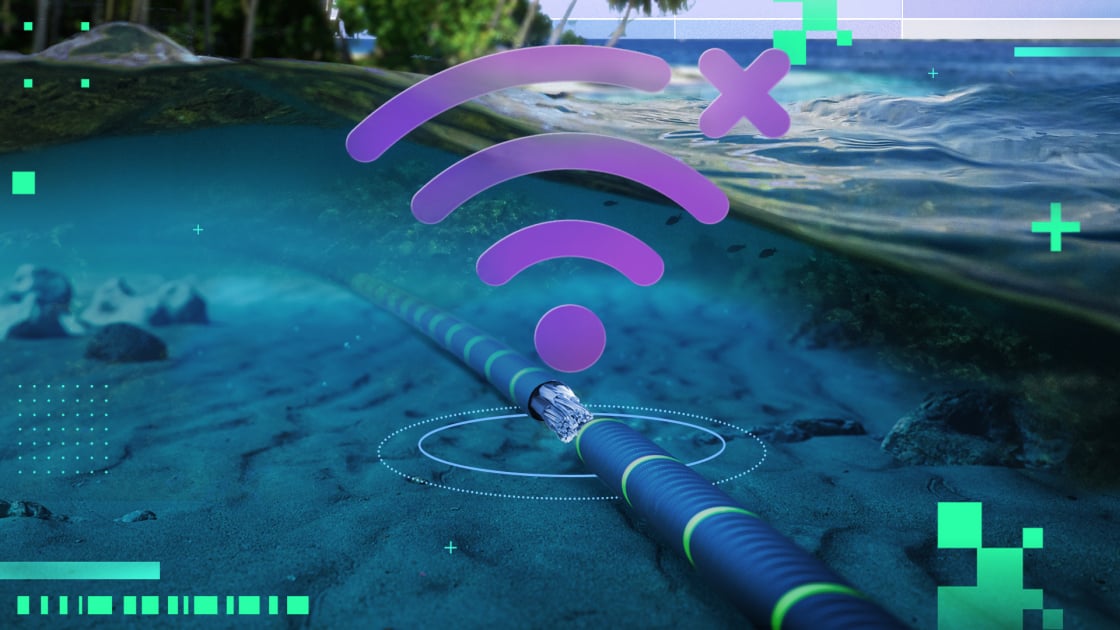It all started with an underwater volcanic eruption. Debris shot into the air, gathering force as it cascaded down the volcano’s flanks, plunged back into the ocean, and sliced Tonga’s only international internet cable in two places, like cutting out the middle of a submarine sandwich.
Tonga, a tiny island nation east of Australia, immediately lost power and internet service. The eruption happened during the pandemic, in 2022, so flights were already suspended. Now, Tonga was officially alone, with no physical or digital connection to the outside world and no way to call for help. Underwater, the middle portion of the cable drifted out to sea, and the two severed ends flailed in the abyss.
Another volcano off the coast of Tonga (Credit: Mike Korostelev / Moment via Getty Images)
“I initially thought Tonga would be thrown back, to say, the 1980s, before it had broadband internet,” says Samanth Subramanian, who tells the full story in his new book, The Web Beneath the Waves, out this week. “But it was more like they went back to the 1880s, around the time they first laid a telegraph line to Tonga, and they would only receive occasional visitors by ship.”
Thrown back in time, residents resorted to paper record-keeping for banking (no credit cards), traveled door-to-door to speak to each other, and grew their own food. Subramanian traveled to the island to write the book, providing a rare firsthand account, and the book covers similar incidents, such as China’s politically motivated attacks on Taiwan’s cables.
Subsea cable map as of September 2025 (Credit:Teleogeography)
Seafloor Garden Hoses, With Way Too Much Power
About the size of a garden hose, subsea cables snake along the seafloor, transporting 95% to 99% of internet traffic, depending on the estimate. They support nearly every aspect of our internet-connected world, making them increasingly critical. Meta, in February, announced plans to build the world’s longest cable, focusing on piping its AI technologies around the world.
Inside each one is a thicket of wires, some about as thin as a strand of hair, in the case of fiber optic cables, says London-based Subramanian. The ends connect to landing stations on the shore, where large servers dole out the traffic to internet providers for nearly every internet activity—content streaming, video calls, stock exchange trades, social media, email, credit cards, medical records, and much more. Even many phone calls run through cables, not old-school phone lines.
Subsea cable on the shore (Credit: IT International Telecom, Inc.)
The duality of how essential, yet vulnerable, they are is what drew Subramanian to immerse himself in the subject and write the book.
“Over the past 10 years, the internet has grown so central to our lives,” Subramanian says. “If a cable were cut in 2002, it would be a lot easier to recover from it. But now, there are a lot of things in our lives that depend on it, and for the internet to be taken away would be a big disaster.”
What happened in Tonga is just a tiny microcosm of what a cable apocalypse would entail. Here’s a taste of Subramanian’s account.
(Credit: Emily Forlini)
The First 4 Days After the Eruption: Panic
The first few days after the eruption were the most challenging for Tonga’s roughly 100,000 residents. Without the ability to call or text anyone, they struggled to confirm the death toll.
“The first 48 hours were chaos,” Subramanian says, as residents walked door to door in the hot, humid weather to check on each other. “The biggest anxiety was not whether the internet would work, it was whether everyone was alive. One government official had to choke back tears when telling me about this time.”
The government organized search parties to check on residents, and foreign embassies did the same for their citizens. Some small planes flew to Tonga’s northern island, Vava’u, to confirm the people there “weren’t fully submerged.” The planes only had basic high-frequency radios for takeoff and landing, and no onboard communication.
Town of Neiafu on Vava’u Island (Credit: Rebecca Harding / Moment via Getty Images)
“Once they realized the death toll was not as bad as they thought, then the second wave of anxiety came in. ‘How do we live without the internet?'” Subramanian says.
Credit cards no longer worked for purchasing food, and the cash on hand ran out, given the defunct ATMs. The government set up centralized food distribution sites on Tonga’s main street. There, people would “buy” items on credit, with hand-written records of what they took. Those in rural areas continued to grow their own food, including those on Vava’u, an example of how those who were less reliant on central, modern systems were most resilient.
“No one went hungry,” Subramanian says. “Tonga being more insular and less integrated into the global economy became an advantage because they were used to relying on the community.” In this sense, Tonga may have been better off during the disaster than a highly developed, internet-dependent country like the US would.
A market on Tongatapu island, Tonga (Credit: Oliver Strewe / The Image Bank Unreleased via Getty Images)
With the power out, largely due to an interruption from the volcanic activity, not the internet, Tongans relied on flashlights and candles. Hospitals used generators for critical functions, but lost access to all patient records.
“I talked to this one woman who thought she was fine because she had a solar panel,” Subramanian says. “But one day it stopped working. She discovered that solar panels that are sold today, like so much else that we buy, also connect to the internet on a regular basis to upgrade their software, and if they can’t do that, they just stop working.”
One of the biggest issues was the inability to call for help. The Tongan government had a satellite phone for emergencies, but it was collecting dust in a closet with an expired subscription. It took four days to straighten that out—Subramanian doesn’t know the exact details of how they got it working—and then they placed the first strategic calls to the governments of Australia and New Zealand, who sent a shipment of medical supplies and food.
Get Our Best Stories!
Your Daily Dose of Our Top Tech News

Sign up for our What’s New Now newsletter to receive the latest news, best new products, and expert advice from the editors of PCMag.
Sign up for our What’s New Now newsletter to receive the latest news, best new products, and expert advice from the editors of PCMag.
By clicking Sign Me Up, you confirm you are 16+ and agree to our Terms of Use and Privacy Policy.
Thanks for signing up!
Your subscription has been confirmed. Keep an eye on your inbox!
One Month Later: Remember Internet Cafes?
Within three to four weeks after the eruption, the power was back, and people had adapted to meet their basic needs. The biggest remaining issue was the internet.
The first connectivity breakthrough came when the government set up three satellite internet hotspots. They functioned like internet cafes, but with limited bandwidth. Residents could come for a short period of time to send an email or text, but when they left, they were back in the dark.
Prime Minister of Tonga’s office (Credt: mtcurado / iStock / Getty Images Plus via Getty Images)
The northern island, Vava’u, remained offline. There, “things got really surreal,” says Subramanian. For banking, someone from a branch on the main island would fly over with a USB drive containing spreadsheets of everyone’s account details, including the amount of money they had. While the banker was there, residents would “deposit” and “withdraw” money and note their activities in the spreadsheet. At the end of the day, the banker would fly back to the main island, Tongatapu, and upload the records into their systems.
“There were tragedies as well as absurdities,” Subramanian says. “People died because they couldn’t be reached in time and so on. It was a pretty tough time.” It got so bad on Vava’u that some people chose to move to the main island.
Two Months Later: Starlink to the Rescue
Starlink terminal (Credit: SpaceX, Starlink)
The next big connectivity breakthrough came from a businessman 6,000 miles away: Elon Musk. His company, SpaceX, donated 50 Starlink internet terminals to Tonga, and the government distributed them across the main island and to Vava’u, marking the first time the region had any connection at all.
The Starlink hubs offered only public Wi-Fi, not residential, but they provided unlimited internet access—a significant upgrade compared with the makeshift internet cafes. One was in a pizza place, for example. “People would come and order a pizza and stay for three hours and do their work,” Subramanian says. “Or, if you couldn’t afford that, you’d go right outside and use the public Wi-Fi. People would be there sitting in their cars, late at night, and using the internet.”
Starlink didn’t solve everything. They still couldn’t call or text friends when they wanted to, which mostly occurred through Facebook Messenger. They also couldn’t use Facebook Marketplace, a main hub for buying and selling goods. This wasn’t ideal, but it wasn’t crippling either.
Recommended by Our Editors
Months Later: Cable Repair—Finally
Subsea cable laying ship (Credit: IT International Telecom, Inc.)
Four months passed, and Tonga’s two cables—the main, international one, and the domestic one going to Vava’u—remained cut. There are only around 70 ships that fix and lay new cables, an incredibly small number given how critical the infrastructure is.
Tonga’s cable has been cut in the past, such as in 2019 when a ship dropped its anchor on it. But this time was different. Since the volcano severed the international cable in two places, the fix wasn’t as simple as knitting the ends together again. Tonga had to order a new, 100km piece to splice in the middle. Then, it had to manufacture and lay a new domestic cable to Vava’u.
Due to the pandemic, this work was challenging to complete, and the factory was already backed up with orders. Even worse, since Tonga is such a small nation, it struggled to get international cable companies to prioritize the work. The small fleet of cable-laying ships is always busy, so securing a spot on the schedule takes time.
“For Tonga to get a window for service was not easy,” Subramanian says. “It’s not like the US, which would have expedited service.”
Six months after the eruption, they fixed the cable, and the main island was back online. But Vava’u was still in the dark, relying on Starlink. It took a whopping 16 months to fix its cable. Finally, the nation’s long nightmare was over, and all residents happily resumed calling, texting, and banking at will—from wherever they wanted to.
At this point, Starlink pulled its free service. “Starlink at that point said, ‘Well, you have to start paying now. Your free window is over, your cables are fine,'” Subramanian says. “There was a government discussion about payment, but to be honest, Tonga can’t afford that.”
Sci-Fi Tale or Harbinger of What Could Happen Anywhere?
The event cast a shadow over the Tongan government, whose officials described the ordeal as “profound and disturbing,” particularly in the context of the isolating pandemic. They expedited the development of a budget and proposed route for a secondary cable, and presented it to partner nations that eventually funded it.
Worldwide, the number of subsea cable-related incidents is growing. Some get cut by accident, from ship anchors or underwater volcanoes. But they are also targets for sabotage. China’s attacks on cables going to Taiwan are on the rise, as are Russia’s on the Baltic countries, The Guardian reports.
“Bad actors, governments, and terrorist groups have realized there’s an easy chokepoint for every country, and that’s its internet,” says Subramanian. “We’re seeing what we think are deliberate attacks start to rise, and governments are aware of this.”
It would take a widespread, coordinated attack to bring down the many cables running to countries like the US, so it’s not time to panic—yet. But what happened in Tonga gives us a tiny window into what the future could hold, or at least the plot of a good sci-fi movie.
Read more in The Web Beneath the Waves, published by Columbia Reports.

Humans could soon live underwater, in these deep sea habitats
About Our Expert

Emily Forlini
Senior Reporter
Experience
As a news and features writer at PCMag, I cover the biggest tech trends that shape the way we live and work. I specialize in on-the-ground reporting, uncovering stories from the people who are at the center of change—whether that’s the CEO of a high-valued startup or an everyday person taking on Big Tech. I also cover daily tech news and breaking stories, contextualizing them so you get the full picture.
I came to journalism from a previous career working in Big Tech on the West Coast. That experience gave me an up-close view of how software works and how business strategies shift over time. Now that I have my master’s in journalism from Northwestern University, I couple my insider knowledge and reporting chops to help answer the big question: Where is this all going?












